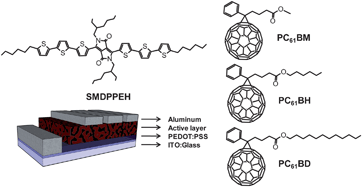A solution processable diketopyrrolopyrrole-containing oligothiophene was blended with a series of methanofullerene acceptors having different alkyl substitutents—[6,6]-phenyl C61 butyric acid methyl (PC6161BM) ester, [6,6]-phenyl C61 butyric acid hexyl ester (PC6161BH) and [6,6]-phenyl C61 butyric acid dodecyl ester (PC6161BD) to study the effect of donor–acceptor interactions on the blend film morphology and device characteristics of small molecule-based bulk heterojunction (BHJ) solar cells. A combination of characterization techniques including X-ray diffraction, atomic force microscopy, conducting atomic force microscopy, and transmission electron microscopy was used to investigate the film morphology and phase separation. The results show that changing the length of the alkyl substituent on the methanofullerene acceptor is a good approach to control the film morphology of blended films and these lead to significant differences on the performance of the as cast and annealed devices. Power conversion efficiencies between 2–3% can be reached by simple variation of the alkyl chain length.

You have access to this article
 Please wait while we load your content...
Something went wrong. Try again?
Please wait while we load your content...
Something went wrong. Try again?


 Please wait while we load your content...
Please wait while we load your content...